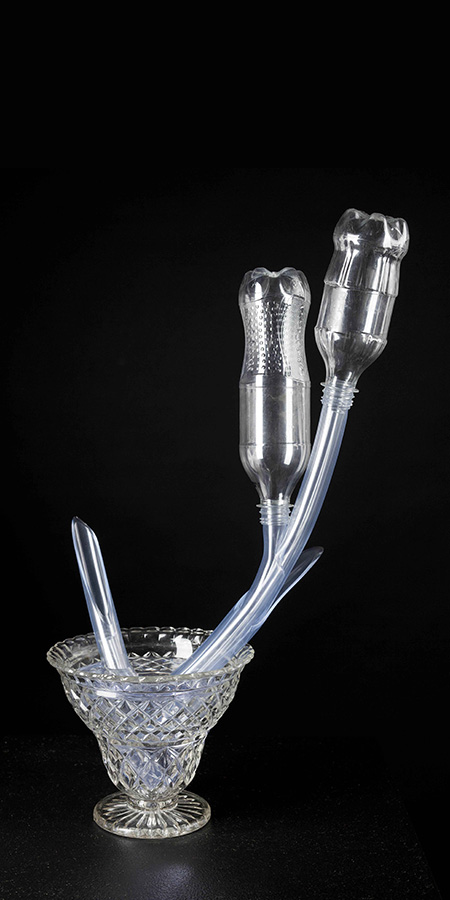Exhibitions / There Is No Land (but the land)
26.05.2012 to 08.07.2012

There is no Land (but the land)
Gipsland Regional Art Gallery - Sale, Victoria
5th June - 7th July 2012
There are among us, present author included, people who have the power to kill anything they touch in a garden. For these people, no amount of love and attention can save their plants and flowers from terminal decline. We see their gardens from the street – overflowing with dead and decaying flowerbeds, barren lawns mottled with weeds, and haggard bushes cowering helplessly into oblivion.
BENEDICT ERNST is one such anxious gardener, whose art practice and curatorial projects have for some time explored his fraught relationship with the plant kingdom. Ernst works with reclaimed materials to conjure up magnificent and opulent floral spectacles – an ode to the ideal garden – assembled entirely from rubbish. We encounter each piece as we might a real plant or flower, and only later apprehend its material components. Where the artist fails with biological matter, he succeeds magnificently with inert and static materials, which are bursting with a life and energy that few actual living species can lay claim to.
For his latest body of work, THERE IS NO LAND (BUT THE LAND), Ernst presents an elaborate array of plants and flowers, arranged in the manner of taxidermy specimens. There are forty pieces in total, presented in grid formation, which altogether represent a catalogue of synthetic plant specimens. While many of the plants seem familiar, none are strictly authentic, and instead comprise the fictional product of the artist’s sometimes obsessive practice. Not content to merely invent a complex and wide-ranging genealogy of plants and flowers, Ernst proposes a new botanical classification system to go with them. The presentation is coldly museological, inert and static. The sense that the plants have blossomed from the soil but have become frozen as scientific exemplars of their alien species is amplified by the almost total absence of colour. Each piece has been crystallized like an ice sculpture – perfect, and at once ephemeral and timeless. The beauty of each work far belies its actual components: plastic bottle tops, straws, tubing, glass, resin, and an abundance of other throwaway junk. In their totality, the plants transcend the sum of their parts and we find ourselves lost in a glittering floral wonderland.
While undoubtedly pretty, the installation serves to call into question our need to classify and categorize everything in the universe. An artist who himself defies categorization, Benedict Ernst is troubled and fascinated by humankind’s obsession with ordering and detail. He harnesses the self-knowing absurdity and futility inherent within his art practice to highlight the absurdity and futility he sees within wider culture. There is also an abiding concern to find calm within the chaos of the world. What might, in disassembled form, amount to a pile of refuse for another artist, for Ernst becomes a fount of material gold. And here lies Ernst’s true genius, his evangelical ability to transform base materials into objects of aesthetic delight. He does not simply re-use disused scrap, he creates magical sculptures whose parts just so happen to have lived previous lives. Recycling is an aspect of Ernst’s practice, not its objective.
Looking further into Benedict Ernst’s crystalline field we find resonances with seventeenth century Dutch still life painting and with early attempts at scientific nomenclature. By inventing a plethora of new plant species he wipes the slate clean, and presents the kind of raw, uncalculated data that greeted scientists in the early Age of Enlightenment. For artists too, there was a scientific curiosity, and the memento mori paintings from this period are rich in detail and respect for the unfathomable wonders of the natural world. Art and science at this time were complementary not competitive, and something of this centuries-old partnership is rekindled in Ernst’s remarkable garden of unearthly delights.
There is fresh hope yet for the inept gardener.
SIMON GREGG - CURATOR
















































